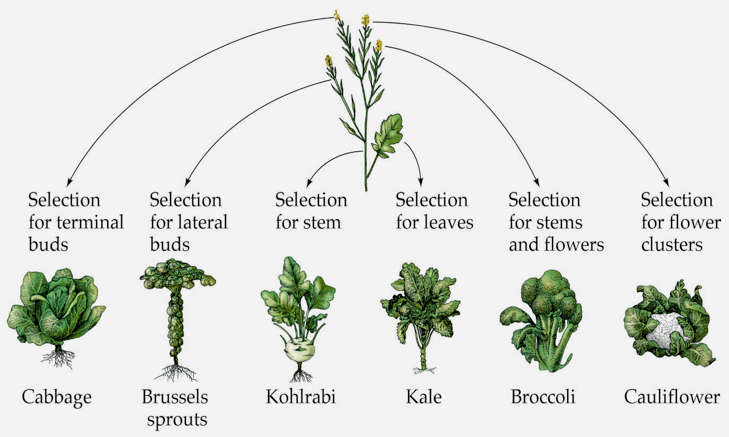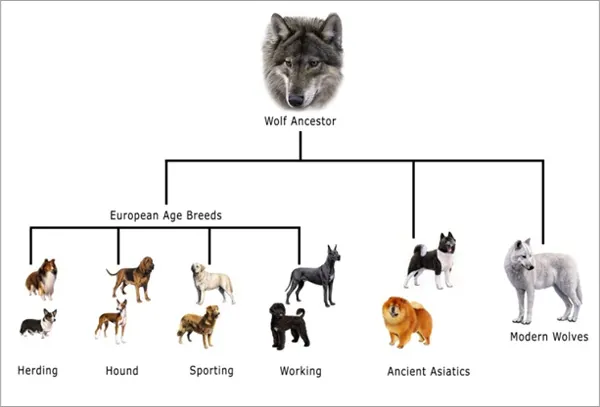Artificial Selection Study Guide
Introduction
Artificial selection, often known as selective breeding, is the action of humans identifying desired qualities in animals and plants and breeding these traits to produce desirable phenotypic traits. Let’s learn about artificial selection in detail.
Defining Artificial Selection
Artificial Selection is a method of selectively developing phenotypic traits (characteristics) in animals and plants by selecting which males and females to sexually reproduce and have progeny together.
Farmed animals are referred to as breeds, and they are usually bred by a professional breeder, whereas domesticated crops are referred to as variety, cultigens, or cultivars.
Crossbreeding occurs when two purebred animals or plants of different breeds crossbreed.
Amateurs, commercial and non-commercial professionals can all breed flowers, vegetables, and fruit trees; large crops are normally the domain of specialists.

Approaches to Artificial Selection
Artificial selection may be divided into three methodologies or categories.
The first is the classic breeder’s strategy, in which a breeder or researcher applies a known level of selection to a particular phenotypic feature by assessing the characteristic and breeding only those with greater or extreme values of that trait.
The second method is known as managed natural selection, essentially natural selection in a controlled setting. In this method, the breeder does not get to pick which of the individuals survive or reproduce, as in the old method.
The third technique is to undertake selection experiments, which evaluate the strength of natural selection in the wild. However, this is more typically an observational approach rather than an experimental technique.
Process of Artificial Breeding
Understand the process of artificial breeding as explained below:
-
There is phenotypic heterogeneity in the population; species with distinct phenotypes/characteristics exist. The breeder chooses an individual with the desired trait.
-
A different subject with the desired phenotype is chosen. The two individuals chosen should not be linked to each other in any way.
-
The two individuals chosen are bred together.
-
When the child reaches maturity, they are tested for the desired characteristic. Those with the highest manifestation of the desired trait are chosen for subsequent breeding.
-
The process continues for several generations, with the best offspring being selected for breeding until all offspring exhibit the desired characteristic.
-
Biological constraints always limit how a character may become excessive in an organism.
Artificial Selection in Racing Horses
For many years, selective breeding has been an important aspect of the horseracing industry. Horses tend to fall into one of three phenotypes, according to breeders:
-
Sprinting short distances is a strength.
-
Long-distance endurance is important.
-
All-rounder
If a breeder intended to produce a sprinting horse, they would most likely undertake the following:
-
Choose the fastest female racing horse they have.
-
Choose the fastest male racing horse they have.
-
Breed the two horses they’ve chosen.
-
Allow their offspring to mature before testing their running speeds to determine which horse is the fastest (male or female)
-
The breeder might race this horse or continue the selective breeding process by mating this horse with another fast horse or a horse bred from quick sprinters.
-
It is hoped that the offspring would all be fast sprinters over numerous generations (although keep in mind that there are biological constraints to this).
Selective Breeding in Dogs
Humans began domesticating wolves some 30,000 to 40,000 years ago. These tamed creatures are now referred to as dogs.
Domestication of wolves has resulted in the loss of several of their more aggressive characteristics, such as instinctual, defensive behavior in the presence of humans (barking or howling, bearing their teeth, preparing to attack, or fleeing), as well as the size and shape of their teeth, over thousands of years.
Instead of selecting for human survival, humans now pick a range of features in dogs based on personal choice and companionship.

✅ Conclusion
-
Artificial selection, often known as selective breeding, is the action of humans identifying desired qualities in animals and plants and breeding these traits to produce desirable phenotypic traits.
-
Biological constraints always limit how a character may become excessive in an organism.
FAQs
1. What are some examples of artificial selection?
Chickens, cattle, lambs, and pigs have been selectively bred to produce the available meats we eat today. Artificial selection has enhanced or even developed several fruits and vegetables. Broccoli, cauliflower, and cabbage, for example, were all developed through selective breeding from the wild mustard species.
2. What is artificial selection in simple terms?
Humans identify desirable qualities in plants and animals and then take methods to improve and maintain those traits in future generations, which is known as artificial selection.
3. What is artificial selection vs. natural selection?
Animals and plants can alter due to natural selection and selective breeding. The distinction is that natural selection occurs without human intervention, whereas selective breeding occurs only when people interfere. As a result, selective breeding is also known as artificial selection.
4. What is artificial selection by Darwin?
The name, not the technique, was coined by Charles Darwin. Artificial selection is breeding animals for desirable qualities using a method other than natural selection or the organism itself. Artificial selection, unlike natural selection, is not random and is guided by human wants.
We hope you enjoyed studying this lesson and learned something cool about Artificial Selection! Join our Discord community to get any questions you may have answered and to engage with other students just like you! Don’t forget to download our App to experience our fun VR classrooms – we promise it makes studying much more fun! 😎
Sources
-
Artificial Selection. https://biologydictionary.net/artificial-selection/. Accessed 20 Dec, 2021.
-
Artificial Selection. https://www.sciencedirect.com/topics/agricultural-and-biological-sciences/artificial-selection. Accessed 20 Dec, 2021.
-
Artificial Selection. https://www.nationalgeographic.org/encyclopedia/artificial-selection/. Accessed 20 Dec, 2021.
